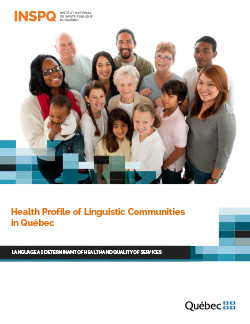Health Profile of Linguistic Communities in Québec
This health profile of linguistic communities is based on data from the 2014-2015 Québec Population Health Survey (QPHS). It addresses a number of topics broken down into 16 indicators covering certain behaviors associated with prevention and health promotion, certain aspects of physical and mental health status, as well as occupational health. Topics addressed in the report cannot be covered with medical or government databases or with census data. The data has been analyzed from a linguistic minority standpoint and according to immigrant status.
The highlights shown here only apply to indicators for which statistically significant differences were observed between the anglophone and allophone linguistic minority communities and the francophone linguistic community.
Linguistic minority status
Compared to francophones, anglophones:
- scored favorably for three indicators: consistent condom use, psychological distress, and non-traumatic work-related musculoskeletal disorders (MSDs);
- scored unfavorably for four indicators: lower contraception use among men and women, cannabis use, and work/life balance;
- did not differ from francophones for the other nine indicators studied.
Compared to francophones, allophones:
- scored favorably for one indicator: unintentional injuries;
- scored unfavorably for four indicators: Pap test, perception of oral health, psychological distress, and work/life balance;
- did not differ from francophones for five of the other indicators studied.
- Data cannot be presented for the other six indicators due to statistical bias.
Minority linguistic status and immigrant status
Compared to francophones, anglophones born in Canada:
- scored favorably for three indicators: consistent condom use, Pap test, and non-traumatic work-related musculoskeletal disorders (MSDs);
- scored unfavorably for four indicators: lower contraception use among women, cannabis use, unintentional injuries as well as work/life balance issues;
- did not differ from francophones on the other nine indicators.
Compared to francophones, immigrant anglophones:
- scored favorably on two indicators: perceived oral health and psychological distress;
- did not differ from francophones on eight indicators; statistical biases prevent comparison for the other six.
Compared to francophones, allophone immigrants:
- scored unfavorably for one indicator: Pap test;
- did not differ from francophones for eight of the other indicators studied; statistical biases prevented comparison for the other seven indicators.


